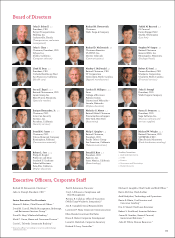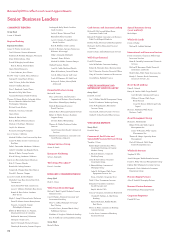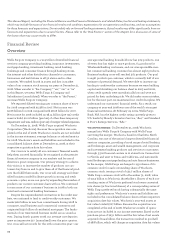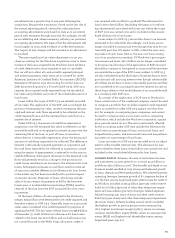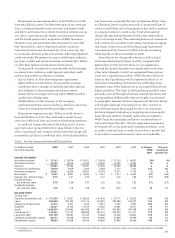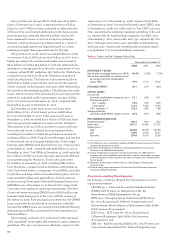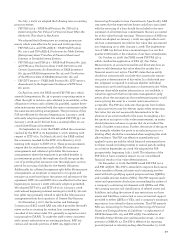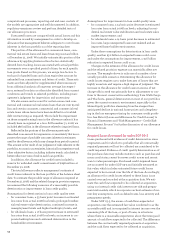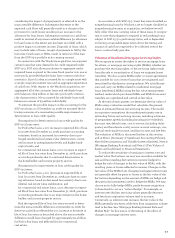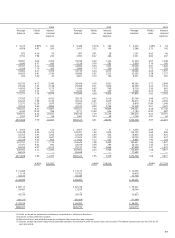Wells Fargo 2008 Annual Report Download - page 41
Download and view the complete annual report
Please find page 41 of the 2008 Wells Fargo annual report below. You can navigate through the pages in the report by either clicking on the pages listed below, or by using the keyword search tool below to find specific information within the annual report.
On July 1, 2008, we adopted the following new accounting
pronouncement:
• FSP FAS 157-3 – FASB Staff Position No. FAS 157-3,
Determining the Fair Value of a Financial Asset When the
Market for That Asset Is Not Active.
We adopted the following new accounting pronounce-
ments, which were effective for year-end 2008 reporting:
• FSP FAS 140-4 and FIN 46(R)-8 – FASB Staff Position
No. 140-4 and FIN 46(R)-8, Disclosures by Public Entities
(Enterprises) about Transfers of Financial Assets and
Interests in Variable Interest Entities;
• FSP FAS 133-1 and FIN 45-4 – FASB Staff Position No. 133-1
and FIN 45-4, Disclosures about Credit Derivatives and
Certain Guarantees: An Amendment of FASB Statement
No. 133 and FASB Interpretation No. 45; and Clarification
of the Effective Date of FASB Statement No. 161; and
• FSP EITF 99-20-1 – FASB Staff Position No. EITF 99-20-1,
Amendments to the Impairment Guidance of EITF Issue
No. 99-20.
On April 30, 2007, the FASB issued FSP FIN 39-1, which
amends Interpretation No. 39 to permit a reporting entity to
offset the right to reclaim cash collateral (a receivable), or the
obligation to return cash collateral (a payable), against deriv-
ative instruments executed with the same counterparty under
the same master netting arrangement. The provisions of this
FSP are effective for the year beginning on January 1, 2008,
with early adoption permitted. We adopted FSP FIN 39-1 on
January 1, 2008, and it did not have a material effect on our
consolidated financial statements.
On September 20, 2006, the FASB ratified the consensus
reached by the EITF at its September 7, 2006, meeting with
respect to EITF 06-4. On March 28, 2007, the FASB ratified
the consensus reached by the EITF at its March 15, 2007,
meeting with respect to EITF 06-10. These pronouncements
require that for endorsement split-dollar life insurance
arrangements and collateral split-dollar life insurance
arrangements where the employee is provided benefits in
postretirement periods, the employer should recognize the
cost of providing that insurance over the employee’s service
period by accruing a liability for the benefit obligation.
Additionally, for collateral assignment split-dollar life insurance
arrangements, an employer is required to recognize and
measure an asset based upon the nature and substance of the
agreement. EITF 06-4 and EITF 06-10 are effective for the year
beginning on January 1, 2008, with early adoption permitted.
We adopted EITF 06-4 and EITF 06-10 on January 1, 2008,
and reduced beginning retained earnings for 2008 by $20 mil-
lion (after tax), primarily related to split-dollar life insurance
arrangements from the acquisition of Greater Bay Bancorp.
On November 5, 2007, the Securities and Exchange
Commission (SEC) issued SAB 109, which provides the staff’s
views on the accounting for written loan commitments
recorded at fair value under U.S. generally accepted account-
ing principles (GAAP). To make the staff’s views consistent
with current authoritative accounting guidance, SAB 109
revises and rescinds portions of SAB 105, Application of
Accounting Principles to Loan Commitments. Specifically, SAB
109 states that the expected net future cash flows associated
with the servicing of a loan should be included in the mea-
surement of all written loan commitments that are accounted
for at fair value through earnings. The provisions of SAB 109,
which we adopted on January 1, 2008, are applicable to writ-
ten loan commitments recorded at fair value that are entered
into beginning on or after January 1, 2008. The implementa-
tion of SAB 109 did not have a material impact on our first
quarter 2008 results or the valuation of our loan commitments.
On October 10, 2008, the FASB issued FSP FAS 157-3,
which clarifies the application of FAS 157, Fair Value
Measurements, in an inactive market and illustrates how an
entity would determine fair value when the market for a
financial asset is not active. The FSP states that an entity
should not automatically conclude that a particular transac-
tion price is determinative of fair value. In a dislocated mar-
ket, judgment is required to evaluate whether individual
transactions are forced liquidations or distressed sales. When
relevant observable market information is not available, a
valuation approach that incorporates management’s judg-
ments about the assumptions that market participants would
use in pricing the asset in a current sale transaction is
acceptable. The FSP also indicates that quotes from brokers
or pricing services may be relevant inputs when measuring
fair value, but are not necessarily determinative in the
absence of an active market for the asset. In weighing a bro-
ker quote as an input to a fair value measurement, an entity
should place less reliance on quotes that do not reflect the
result of market transactions. Further, the nature of the quote
(for example, whether the quote is an indicative price or a
binding offer) should be considered when weighing the avail-
able evidence. The FSP was effective immediately and
applied to prior periods for which financial statements have
not been issued, including interim or annual periods ending
on or before September 30, 2008. We adopted the FSP
prospectively, beginning July 1, 2008. The adoption of the
FSP did not have a material impact on our consolidated
financial results or fair value determinations.
On December 11, 2008, the FASB issued FSP FAS 140-4
and FIN 46(R)-8. This FSP is intended to improve disclosures
about transfers of financial assets and continuing involve-
ment with both qualifying special purpose entities (QSPEs)
and variable interest entities (VIEs). The FSP requires quali-
tative and quantitative disclosures surrounding the nature of
a company’s continuing involvement with QSPEs and VIEs,
the carrying amount and classification of related assets and
liabilities, including the nature of any restrictions on those
assets and liabilities; contractual or non-contractual support
provided to either QSPEs or VIEs; and a company’s maximum
exposure to loss related to these activities. This FSP amends
FAS 140, Accounting for Transfers and Servicing of Financial
Assets and Extinguishments of Liabilities – a replacement of
FASB Statement No. 125, and FIN 46(R), Consolidation of
Variable Interest Entities (revised December 2003) – an inter-
pretation of ARB No. 51. The FSP is effective for reporting
periods (annual or interim) ending after December 15, 2008.




